[English] 日本語
 Yorodumi
Yorodumi- PDB-1jca: Non-standard Design of Unstable Insulin Analogues with Enhanced A... -
+ Open data
Open data
- Basic information
Basic information
| Entry | Database: PDB / ID: 1jca | ||||||
|---|---|---|---|---|---|---|---|
| Title | Non-standard Design of Unstable Insulin Analogues with Enhanced Activity | ||||||
 Components Components |
| ||||||
 Keywords Keywords | HORMONE/GROWTH FACTOR / A8-Lysine human insulin / insulin receptor / HORMONE-GROWTH FACTOR COMPLEX | ||||||
| Function / homology |  Function and homology information Function and homology informationnegative regulation of glycogen catabolic process / positive regulation of nitric oxide mediated signal transduction / negative regulation of fatty acid metabolic process / negative regulation of feeding behavior / Signaling by Insulin receptor / IRS activation / regulation of protein secretion / Insulin processing / positive regulation of peptide hormone secretion / positive regulation of respiratory burst ...negative regulation of glycogen catabolic process / positive regulation of nitric oxide mediated signal transduction / negative regulation of fatty acid metabolic process / negative regulation of feeding behavior / Signaling by Insulin receptor / IRS activation / regulation of protein secretion / Insulin processing / positive regulation of peptide hormone secretion / positive regulation of respiratory burst / negative regulation of acute inflammatory response / Regulation of gene expression in beta cells / alpha-beta T cell activation / positive regulation of dendritic spine maintenance / Synthesis, secretion, and deacylation of Ghrelin / activation of protein kinase B activity / negative regulation of protein secretion / negative regulation of gluconeogenesis / positive regulation of insulin receptor signaling pathway / positive regulation of glycogen biosynthetic process / fatty acid homeostasis / negative regulation of respiratory burst involved in inflammatory response / Signal attenuation / FOXO-mediated transcription of oxidative stress, metabolic and neuronal genes / negative regulation of lipid catabolic process / positive regulation of lipid biosynthetic process / negative regulation of oxidative stress-induced intrinsic apoptotic signaling pathway / regulation of protein localization to plasma membrane / nitric oxide-cGMP-mediated signaling / transport vesicle / COPI-mediated anterograde transport / positive regulation of nitric-oxide synthase activity / Insulin receptor recycling / negative regulation of reactive oxygen species biosynthetic process / positive regulation of brown fat cell differentiation / insulin-like growth factor receptor binding / NPAS4 regulates expression of target genes / neuron projection maintenance / endoplasmic reticulum-Golgi intermediate compartment membrane / positive regulation of mitotic nuclear division / Insulin receptor signalling cascade / positive regulation of glycolytic process / positive regulation of cytokine production / endosome lumen / positive regulation of long-term synaptic potentiation / acute-phase response / positive regulation of D-glucose import across plasma membrane / positive regulation of protein secretion / insulin receptor binding / positive regulation of cell differentiation / Regulation of insulin secretion / wound healing / positive regulation of neuron projection development / hormone activity / regulation of synaptic plasticity / negative regulation of protein catabolic process / positive regulation of protein localization to nucleus / Golgi lumen / cognition / vasodilation / glucose metabolic process / insulin receptor signaling pathway / cell-cell signaling / glucose homeostasis / regulation of protein localization / PI5P, PP2A and IER3 Regulate PI3K/AKT Signaling / positive regulation of cell growth / protease binding / secretory granule lumen / positive regulation of canonical NF-kappaB signal transduction / positive regulation of phosphatidylinositol 3-kinase/protein kinase B signal transduction / positive regulation of MAPK cascade / positive regulation of cell migration / G protein-coupled receptor signaling pathway / endoplasmic reticulum lumen / Amyloid fiber formation / Golgi membrane / negative regulation of gene expression / positive regulation of cell population proliferation / positive regulation of gene expression / regulation of DNA-templated transcription / extracellular space / extracellular region / identical protein binding Similarity search - Function | ||||||
| Method |  X-RAY DIFFRACTION / X-RAY DIFFRACTION /  FOURIER SYNTHESIS / Resolution: 2.5 Å FOURIER SYNTHESIS / Resolution: 2.5 Å | ||||||
 Authors Authors | Weiss, M.A. / Wan, Z. / Zhao, M. / Chu, Y.-C. / Nakagawa, S.H. / Burke, G.T. / Jia, W. / Hellmich, R. / Katsoyannis, P.G. | ||||||
 Citation Citation |  Journal: J.Mol.Biol. / Year: 2002 Journal: J.Mol.Biol. / Year: 2002Title: Non-standard insulin design: structure-activity relationships at the periphery of the insulin receptor. Authors: Weiss, M.A. / Wan, Z. / Zhao, M. / Chu, Y.C. / Nakagawa, S.H. / Burke, G.T. / Jia, W. / Hellmich, R. / Katsoyannis, P.G. #1:  Journal: BIOPHYS.CHEM. / Year: 1994 Journal: BIOPHYS.CHEM. / Year: 1994Title: A Proposed Interaction Model of Insulin Molecules with its Receptor Authors: Liang, D.C. / Chang, W.R. / Wan, Z.L. / Vijayan, N.M. #2:  Journal: Proc.Natl.Acad.Sci.USA / Year: 2000 Journal: Proc.Natl.Acad.Sci.USA / Year: 2000Title: Diabetes-associated Mutations in a beta-Cell Transcription Factor Destabilize an Antiparallel "mini-zipper" in a Dimerization Interface Authors: Hua, Q.X. / Zhao, M. / Narayana, N. / Nakagawa, S.H. / Jia, W. / Weiss, M.A. #3:  Journal: J.Mol.Biol. / Year: 1998 Journal: J.Mol.Biol. / Year: 1998Title: The Relationship Between Insulin Bioactivity and Structure in the NH2-terminal A-chain Helix Authors: Olsen, H.B. / Ludvigsen, S. / Kaarsholm, N.C. #4:  Journal: J.Mol.Biol. / Year: 1996 Journal: J.Mol.Biol. / Year: 1996Title: Mapping the Functional Surface of Insulin by Design: Structure and Function of Novel A-chain Analogue Authors: Hua, Q.X. / Hu, S.Q. / Frank, B.H. / Jia, W. / Chu, Y.C. / Wang, S.H. / Burke, G.T. / Katsoyannis, P.G. / Weiss, M.A. | ||||||
| History |
| ||||||
| Remark 400 | COMPOUND The crystallographic asymmetric unit of insulin consists of two insulin monomers each ...COMPOUND The crystallographic asymmetric unit of insulin consists of two insulin monomers each consisting of two heterochains. The entry presents coordinates for monomer 1 (chain indicators A and B) and monomer 2 (chain indicators C and D). There are two zinc ions per insulin hexamer located on the three-fold axis. The conformations of two monomers are different as the result of a change in conformation of the first eight residues of the B-chain. |
- Structure visualization
Structure visualization
| Structure viewer | Molecule:  Molmil Molmil Jmol/JSmol Jmol/JSmol |
|---|
- Downloads & links
Downloads & links
- Download
Download
| PDBx/mmCIF format |  1jca.cif.gz 1jca.cif.gz | 33.3 KB | Display |  PDBx/mmCIF format PDBx/mmCIF format |
|---|---|---|---|---|
| PDB format |  pdb1jca.ent.gz pdb1jca.ent.gz | 23.1 KB | Display |  PDB format PDB format |
| PDBx/mmJSON format |  1jca.json.gz 1jca.json.gz | Tree view |  PDBx/mmJSON format PDBx/mmJSON format | |
| Others |  Other downloads Other downloads |
-Validation report
| Summary document |  1jca_validation.pdf.gz 1jca_validation.pdf.gz | 369.6 KB | Display |  wwPDB validaton report wwPDB validaton report |
|---|---|---|---|---|
| Full document |  1jca_full_validation.pdf.gz 1jca_full_validation.pdf.gz | 369.6 KB | Display | |
| Data in XML |  1jca_validation.xml.gz 1jca_validation.xml.gz | 3.2 KB | Display | |
| Data in CIF |  1jca_validation.cif.gz 1jca_validation.cif.gz | 4.8 KB | Display | |
| Arichive directory |  https://data.pdbj.org/pub/pdb/validation_reports/jc/1jca https://data.pdbj.org/pub/pdb/validation_reports/jc/1jca ftp://data.pdbj.org/pub/pdb/validation_reports/jc/1jca ftp://data.pdbj.org/pub/pdb/validation_reports/jc/1jca | HTTPS FTP |
-Related structure data
| Related structure data | 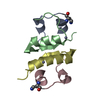 1j73C 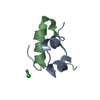 1trzS C: citing same article ( S: Starting model for refinement |
|---|---|
| Similar structure data |
- Links
Links
- Assembly
Assembly
| Deposited unit | 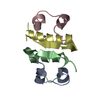
| |||||||||
|---|---|---|---|---|---|---|---|---|---|---|
| 1 | 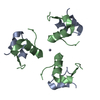
| |||||||||
| 2 | 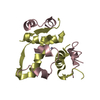
| |||||||||
| 3 | 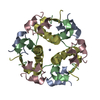
| |||||||||
| Unit cell |
| |||||||||
| Components on special symmetry positions |
| |||||||||
| Details | The biological assembly is a hexamer generated from the dimer in the asymmetric unit by the operations: -y, x-y, z and -x+y, -x, z. |
- Components
Components
| #1: Protein/peptide | Mass: 2411.774 Da / Num. of mol.: 2 / Mutation: T8K / Source method: obtained synthetically Details: This peptide was chemically synthesized. The sequence of the peptide is naturally found in Homo sapiens (humans). References: UniProt: P01308 #2: Protein/peptide | Mass: 3433.953 Da / Num. of mol.: 2 / Source method: obtained synthetically Details: This peptide was chemically synthesized. The sequence of the peptide is naturally found in Homo sapiens (humans). References: UniProt: P01308 #3: Chemical | #4: Water | ChemComp-HOH / | Has protein modification | Y | |
|---|
-Experimental details
-Experiment
| Experiment | Method:  X-RAY DIFFRACTION / Number of used crystals: 1 X-RAY DIFFRACTION / Number of used crystals: 1 |
|---|
- Sample preparation
Sample preparation
| Crystal | Density Matthews: 2.03 Å3/Da / Density % sol: 39.43 % | ||||||||||||||||||||||||||||||||||||||||||||||||||||||||
|---|---|---|---|---|---|---|---|---|---|---|---|---|---|---|---|---|---|---|---|---|---|---|---|---|---|---|---|---|---|---|---|---|---|---|---|---|---|---|---|---|---|---|---|---|---|---|---|---|---|---|---|---|---|---|---|---|---|
| Crystal grow | Method: vapor diffusion, hanging drop / pH: 7 Details: Tris, sodium citrate, acetone, phenol, pH 7.0, VAPOR DIFFUSION, HANGING DROP Temp details: ambient | ||||||||||||||||||||||||||||||||||||||||||||||||||||||||
| Crystal grow | *PLUS pH: 7.8 | ||||||||||||||||||||||||||||||||||||||||||||||||||||||||
| Components of the solutions | *PLUS
|
-Data collection
| Diffraction | Mean temperature: 290 K |
|---|---|
| Diffraction source | Source:  ROTATING ANODE / Type: RIGAKU RU200 / Wavelength: 1.5418 Å ROTATING ANODE / Type: RIGAKU RU200 / Wavelength: 1.5418 Å |
| Detector | Type: RIGAKU RAXIS II / Detector: IMAGE PLATE / Date: Jan 1, 2000 / Details: mirrors |
| Radiation | Monochromator: MIRROR / Protocol: SINGLE WAVELENGTH / Monochromatic (M) / Laue (L): M / Scattering type: x-ray |
| Radiation wavelength | Wavelength: 1.5418 Å / Relative weight: 1 |
| Reflection | Resolution: 2.5→10 Å / Num. all: 3369 / Num. obs: 3169 / % possible obs: 99.2 % / Observed criterion σ(F): 2 / Observed criterion σ(I): 1 / Redundancy: 2 % / Rmerge(I) obs: 0.071 |
| Reflection shell | Resolution: 2.5→2.59 Å / Rmerge(I) obs: 0.16 / % possible all: 97.5 |
| Reflection | *PLUS Rmerge(I) obs: 0.076 |
- Processing
Processing
| Software |
| |||||||||||||||||||||||||
|---|---|---|---|---|---|---|---|---|---|---|---|---|---|---|---|---|---|---|---|---|---|---|---|---|---|---|
| Refinement | Method to determine structure:  FOURIER SYNTHESIS FOURIER SYNTHESISStarting model: PDB ENTRY 1TRZ Resolution: 2.5→10 Å / σ(F): 2 / σ(I): 1
| |||||||||||||||||||||||||
| Refinement step | Cycle: LAST / Resolution: 2.5→10 Å
| |||||||||||||||||||||||||
| Refine LS restraints |
| |||||||||||||||||||||||||
| Software | *PLUS Name:  X-PLOR / Version: 3.1 / Classification: refinement X-PLOR / Version: 3.1 / Classification: refinement | |||||||||||||||||||||||||
| Refinement | *PLUS Highest resolution: 2.5 Å / Lowest resolution: 10 Å / σ(F): 2 / Rfactor obs: 0.204 | |||||||||||||||||||||||||
| Solvent computation | *PLUS | |||||||||||||||||||||||||
| Displacement parameters | *PLUS | |||||||||||||||||||||||||
| Refine LS restraints | *PLUS
|
 Movie
Movie Controller
Controller


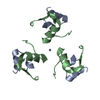
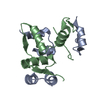
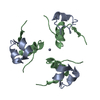
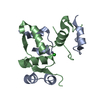
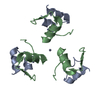
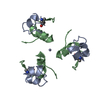
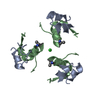
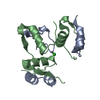
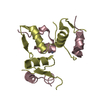
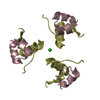
 PDBj
PDBj




















